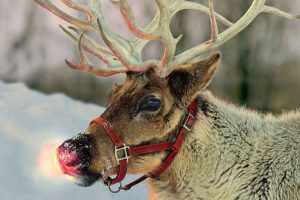- A way in which the Rudolph the Red-Nosed Reindeer story makes sense;
- Contemplating the range of all human activities, including playing games and telling stories;
- The Mojave Desert, and Apple Valley as a portal between two worlds.
Posted on Facebook by Geoffrey A. Landis, 15 Dec 2023. I’ll quote, and add line breaks. Though I’m not certain whether this is original with Landis, or something he’s passing along.
People aren’t giving Santa enough credit.
People are complaining that Santa didn’t stop all of the other reindeer from bullying poor Rudolph, but look:
He’s hundreds of years old. He’s delivered toys everywhere on the Earth from Svalbard to Tierra del Fuego. One thing we can say for sure is that he knows how to drive a sleigh in fog. He never needed Rudolph’s shiny nose to “guide his sleigh” because of a little fog; he could do it in his sleep.
But, he knows reindeer are herd animals. By announcing Rudolph to be lead reindeer, he knew the rest would have no choice but to accept his social status.
The reindeer were picking on poor Rudolph, Santa saw it, and solved the problem with no fuss, no harsh words, and without hurting anybody.
Well done, Santa. Well done.
I find this fascinating. It points out the implausibility of the Rudolph story, taken at face value, then suggests a “real” reason why Santa did what he did — which involves him, implicitly, telling a fib. I suspect many stories are like this, especially the religious stories and the holiday myths and the nationalistic parables about heroes of the revolution. Stories that don’t make much sense at face value, but which continue to be told. They must serve some value, perhaps assuaging the deep narrative bias humans have for making sense of the world in terms of cause and effects, beginnings and middles and ends.
This is a theme of my essay, and book in progress, as this narrative bias pertains to science fiction. Though I suspect there must be a huge body of academic studies out there about this — see here! Narratology — which I need to familiarize myself with, at least glancingly, before I presume any new insights.
\\
The next day I wrote down late-night thoughts based on discussing the Rudolph take over dinner. And thinking about what people do with the lives, day to day, when they’re not merely doing the basic work of survival — working a job, raising children. I’ll quote myself:
Contrast playing (by children), telling stories (adults – movies, tv, books), science (finding solutions to problems), games (zero-sum, winners and losers — sports), puzzles (finding solutions to problems), and competitive existence (which may or may not involve zero-sum games).
Very broadly speaking, do all human activities fall within these groups? Or are there others?
At dinner last night cited example from Fb about what the Rudolph story ‘really’ means. The difference between superficial meaning, which doesn’t add up on close examination, and psychological meaning – the appeal of stories. Thus, why are certain stories retold for generations, even if they are superficially implausible? Because they appease psychological intuitions about how the world works, based on humanity’s evolutionary past environment. Thus all religion.
\\
I had another insight, another that may be useful for my book, as we drove back home from Las Vegas on the 29th. I noticed that the landscape of the thousands of square miles of desert in southeast California, which thousands or perhaps even millions of people drive through on I15 every year (just going from LA to LV and back), is much like the edge of the desert where I grew up, in Apple Valley. Not a flat desert, but a rocky, hilly desert, a mix of peaks up to 6000 or 7000 feet and lowlands down to sea level. The I15 itself descends to near sea-level at Baker, and some says beyond crosses a pass at just under 5000 feet.
That is, the place I grew up, Apple Valley, is only the very edge of a vast, mysterious, largely uninhabited and even unexplored, interior. It’s not particularly distinctive compared to that entire desert — but it is at the edge of it. Apple Valley might thus be considered a kind of portal, between the vast desert to the northeast, and just above the blue mountain ranges to the south, beyond which lie the magical habitations of Los Angeles and the Inland Empire
And I can use my childhood experience growing up in Apple Valley as a narrative device. An example of discovering the world, one stage at a time, that is bigger and more complex than childhood experience. An analogy to humanity’s discovery of the universe.
Nonfiction books benefit from personal anecdotes, I’ve noticed again and again. And I think I have some good ones I can use.






